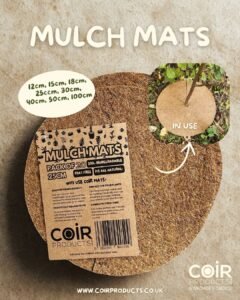
Transform Your Garden with Biodegradable Mulch Mats
In a world where every choice we make ripples through our planet and our personal sanctuary, your garden deserves more than the ordinary. It deserves

CoirProducts Featured Grower this week is Mark Lane (@marklanetv), garden designer, TV and radio broadcaster, voiceover, actor, and writer. In this blog post, Mark shared with us how he became a garden designer, the difficulties he faced and how he overcame them, and what he loves to grow. He also tells us what it means to design a garden that is accessible and inclusive for all. Mark also shared with us how much gardening and spending time in nature has benefitted him, calling it his ‘green pill’. He reminds us, constantly, how important it is to ‘think outside the box’, when it comes to being more sustainable and overcoming difficulties and challenges. Read on to find out all about Mark’s inspiring gardening journey.
Tell us a little bit about you and what inspired you to become a garden designer? We understand that you were working in publishing earlier, and following a car accident and a period of rehabilitation, you turned more towards nature and gardening, and pursued a career in garden design. We would love to know more.
As a child I would follow my grandad around his large garden, pulling a blue truck with a pair of blunt scissors, some string and seeds. He taught me about the soil, how to sow seeds, how to care for plants, etc. My nan was a flower arranger and she taught me about colour combinations, textures, foliage and so much more. Then fast forward 20 or so years and I was in publishing as the Publishing Director for the Royal Institute of British Architects, where I worked with many landscape architects, and as the Managing Editor for the international Arts publisher Thames & Hudson, where I published many gardening books. It was around this time that my husband and I bought our first house with a garden in SE London and then out to Kent. I started to learn more about plants, how to grow different plants and how to get interest for 12 months of the year. I have been told that I have an encyclopaedic brain for plants – I suppose because I love plants the information just sinks in and stays.
Then, in 2000 I was in a car accident and during my rehabilitation at the Royal National Orthopaedic Hospital in Stanmore, I had the great fortune of having a horticultural therapist who helped me along a difficult and painful journey. Then, when I finally got home, it was my husband who said ‘let’s get outside’. I did, and for those 10 minutes, I forgot about the accident, the pain, the journey ahead, and just focused on the colours, scents, and textures that surrounded me, as well as the sun on my face. It was also my husband who said, ‘why don’t you do something with plants’, as I was considering handing in my notice at the publishing house, as I didn’t want to travel to London everyday and didn’t think I could travel everyday to London in a wheelchair. So, I started hunting for online garden design courses, using my love for plants, my art background (studied art history at UCL) and my understanding of the relationship between architecture and the environment, from my days at RIBA. I finally found a course at KLC School of Design and did an open learning course.

In a world where every choice we make ripples through our planet and our personal sanctuary, your garden deserves more than the ordinary. It deserves

We continue our special series highlighting grower’s experience of using coir with Kay @brook_cottage_. With a love for growing a mix of flowers, fruits, and